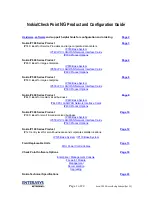
12-7
Cisco Catalyst Blade Switch 3130 and 3032 for Dell Software Configuration Guide
OL-12247-04
Chapter 12 Configuring Smartports Macros
Configuring Smartports Macros
You can delete a global macro-applied configuration on a switch only by entering the
no
version of each
command that is in the macro. You can delete a macro-applied configuration on an interface by entering
the
default interface
interface-id
interface configuration command.
This example shows how to display the
cisco-desktop
macro, how to apply the macro, and to set the
access VLAN ID to 25 on an interface:
Switch#
show parser macro cisco-desktop
--------------------------------------------------------------
Macro name : cisco-desktop
Macro type : default
# Basic interface - Enable data VLAN only
# Recommended value for access vlan (AVID) should not be 1
switchport access vlan $AVID
switchport mode access
# Enable port security limiting port to a single
# MAC address -- that of desktop
switchport port-security
switchport port-security maximum 1
# Ensure port-security age is greater than one minute
# and use inactivity timer
switchport port-security violation restrict
switchport port-security aging time 2
switchport port-security aging type inactivity
# Configure port as an edge network port
spanning-tree portfast
spanning-tree bpduguard enable
--------------------------------------------------------------
Switch#
Switch#
configure terminal
Switch(config)#
gigabitethernet1/0/4
Switch(config-if)#
macro apply cisco-desktop $AVID 25
Step 7
macro
{
apply
|
trace
}
macro-name
[
parameter
{
value
}] [
parameter
{
value
}] [
parameter
{
value
}]
Append the Cisco-default macro with the required values by using the
parameter
value
keywords, and apply the macro to the interface.
Keywords that begin with
$
mean that a unique parameter value is
required.
You can use the
macro apply
macro-name
?
command to display a list
of any required values in the macro. If you apply a macro without
entering the keyword values, the commands are invalid and are not
applied.
Step 8
end
Return to privileged EXEC mode.
Step 9
show running-config
interface
interface-id
Verify that the macro is applied to an interface.
Step 10
copy running-config startup-config
(Optional) Save your entries in the configuration file.
Command
Purpose









































